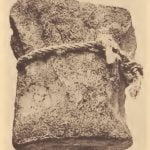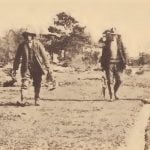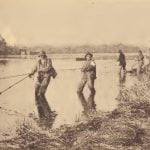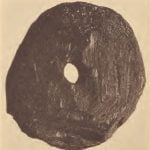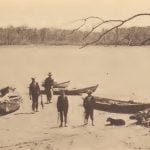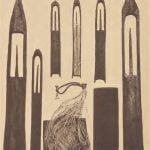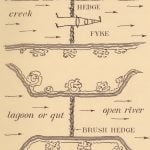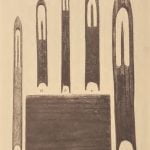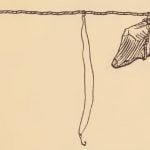The Powhatan tribes still adhere to some fishing practices worth mentioning. Until not long ago fish fences were employed. These were chiefly for sturgeon, but now this splendid fish is so scarce that whereas thirty years ago from three to six a day during July and August would be taken, now the record is three a season by six boats fishing the same period. Captain John Smith mentions 52 and 68 being taken ”at a draught.” 1
The Virginia explorers noted the great abundance of sturgeon, and we may imagine that the fish contributed largely to the abundance of food of the early Indians. The method employed in the construction of the fish-pond or “bush-net” is described by several of the men at Pamunkey and Mattaponi. At the entrance of the smaller creeks, or guts, branching off from the main streams there was built a barrier of poles several feet apart driven upright into the ever-present mud at low tide when the water is out of the place.
The “bush-nets” or “hedges” are well remembered by John Langston as having been worked by his father some seventy-five years ago. They were known and described among the neighboring Delawares and Nanticoke in early colonial times.
The “hedges” were made low enough in some instances so that the fish could pass over their tops at high tide. Then, as the water went out on the ebb, they would be barred from returning to the river (fig. 65). In the enclosures where the water might be from six to eight feet deep the hunters could shoot the impounded fish with arrows or spear them with iron-pointed prongs. In the deep holes the sturgeon caught by the “hedges” were hooked with a jig-hook. They would sometimes jump the barrier. ”Hedging” was more practicable near the headwaters of the rivers, frequently above tidewater.
Each man had his own enclosure. They were generally about a mile apart. Two or three men would combine and work together as partners in the enclosures. The crews respected each other’s rights of ownership. Then sometimes they would move their ”hedges” a mile or so up or down stream, all the crews shifting at the same time. The reason for this change is given as growing out of an idea that they could do better by it. A final word of description adds the information that the lattice-work of the “hedges” was so constructed as to slope upstream. I might add that similar weirs may be seen in the streams of the Cherokee country 2. In that region stones are available for construction and are used in the wings of the dam, the trap of slats being set at an opening where the fish are obliged to pass. In the Powhatan area, however, no stones suitable for such a purpose exist.
For several generations shad fishing has been an important industry among the tidewater Indians. It is, indeed, one of their principal harvests. Easter time is the height of the shad season with them. At Pamunkey they have a belief that the shad arrive in the river at the time when the white violet blooms; hence they have the name ”shad-flower” for it. Drift seines are employed in the same way as among the white people. Day and night the seines are tended by the men who bivouac in camp huts of boards along the shore. For several weeks many of them are not home for a night’s sleep.
The seines at night are provided with board floats at each end carrying a lighted lantern. By this their position is known when it is thought time to haul them. Six or seven seines with their lights riding on the river, the seiners’ campfire on the shore, and the somber wooded swamps on both sides make an impressive picture on an April night. The great barred owls call forth the quarter, half, and full tides, so the Indians of all the Virginia tribes say and believe. This saying can well be accredited with a basis of truth, for it is a rare hour when one or more of the resounding human-like series of whoops does not echo from the swamp, so loud that it rises above all other sounds of the night.
Herring also form a spring catch of importance. These fish are looked for when the locust and the dogwood commence to bloom. Among not only the Pamunkey, but among the other river tribes, the Mattaponi and Chickahominy, the same natural signs are consulted for the timing of industry. For instance, they believe that eels may be more profitably caught in the full of the moon. Among the Pamunkey a fondness for catfish in the form of stew is increased by a belief that it stimulates sexual desires. Nothing could exceed their relish for it. The same belief is current among the other tribes, as well as the Blackes, of the region.
Although I have fished all the different methods with the three river tribes just mentioned and have persistently inquired among the older people, nothing more than the tradition of catching fish by poison has been encountered. The poisoning method so well known and widely distributed among the southeastern tribes, especially the Muskogi, may have been employed in Virginia too, but there is no definite allusion to it in the records. The reason for this may be found to have a basis in the physiographic of the country. Being subject to a two- or three-foot tidal inundation, the rivers of the Virginia coastal plain do not furnish suitable permanent pools in which the fish poison may be distributed. Moreover, the fish supply is so abundant and varied that other methods are more expeditious and productive. A review of the poisoning practice, I believe, will show that its distribution in the south-east is limited to freshwater river regions. This topic is, at any rate, about ripe for investigation.
Fish shooting with the bow and arrow is well remembered among the older Pamunkey and Mattaponi. The bow is the usual article; the arrow, the “arrow-wood” shaft tipped with a ferrule point.
No string, however, was in recent times attached to the arrow, as was the case among some of the more southerly people who relied upon the string to pull out the fish when struck. Captain Smith in 1612 mentioned the natives shooting fish with arrows tied by a line. 3
At Pamunkey the fish-hunter goes down to one of the ponds or tidal pools toward evening where he finds the ”cow fish” or ”stiff- backed perch” guarding their young so the other fish will not eat them, and shoots them from the bank. Fish-shooting is a typical southern practice and may be regarded as one of the southeastern acculturations of the Virginia Algonquians.
While hand-made nets have been completely superseded by the nets of commerce, there is still abundant reason for the preservation of the netting technique in this region. Repairing or “hanging” is constantly required, and then there are some of the poorer fishermen who are occasionally obliged to make their own nets. From a number of the eastern tribal remnants the usual tongued netting-needle of the European pattern has been collected and studied by Hallowell. The netting implements at Pamunkey and Mattaponi (figs. 70, 71) are practically identical with those of the eastern Algonquians now from North Carolina to Labrador. Those illustrated here show the different-sized needles employed in making nets for use with varying kinds of fish, the largest one for sturgeon nets, the others for shad and herring seines. The measuring blocks, too (figs. 70, e; 71, c, d), are in correspondence with those of the general area. I need only add the expected statement that the universal ”becket- knot” is employed. While the use of seines has been the principal method in recent years, the Indians seem to think that it was introduced by the English. 4 The so called net-sinkers are not found on these rivers at all. This is significant. The Powhatan undoubtedly could and did make small nets for use in the hand or with pole handles. The net topic among the eastern Algonkians is, however, under treatment at the hands of Hallowell. 5
A general practice of using set-lines (fig. 72) for catfish is followed by practically all the men on the reservations at Pamunkey and Mattaponi. The lines are of heavy cord, 250 to 300 feet long. At distances of 18 inches apart are tied the hooks on string leaders 12 inches in length. At intervals along the set-line stone sinkers are tied. In this case just natural, rough, square-edged stones from the shore are taken. One end of the set-line is attached to a stout pole stuck into the mud bottom, and the other rides the surface tied to a bottle. By this means the set-line is kept in one place where the catfish are obliged to pass following the channel. The stone sinkers keep the line on the bottom where the catfish feed, and the floating end of the line allows ample play for the tides. The hooks are baited with cut-up minnows. Generally the bait is renewed every other day. At each average haul of such a line 60 to 100 catfish are taken. Oftentimes mussels attach themselves to the bait and are brought up. Then the fisherman takes them home to be made into stew. The fisherman’s task is vigorous and varied. About every other evening he is obliged to haul a small minnow seine to replenish the bait. He takes up his set-line early in the morning, removing the captured fish and rebaiting at the same time.
It takes about two hours to ”haul and bait” the two set-lines that each fisherman operates. While the canoe tosses and lurches, when the wind is high and the waves are raised by wind against tide, it is difficult to hold it to the line with the hands employed on the hooks. So a nail is driven into the gunwale and the set-line run over it as it is passed along, keeping the canoe and line together while the hauling and baiting are accomplished. Like the Algonquians in general, the Pamunkey is essentially a river-man.
The fishing customs of the Pamunkey should not be passed over without reference to an interesting habit of some of the women in preferring to scale their shad with a stone scraper instead of a metal knife — a custom of survival from their stone age. Specimens obtained from old fish-houses and one still in use by the wife of Chief Cook are shown in fig. 76. Mrs. Cook had found hers at an old house-site. The claim is made that these implements remove scales without cut-ting flesh or fingers. During practically the whole year the tidewater tribes draw upon the river for their food supply. Shad, drum, roach, perch, gar, catfish, eels, formerly sturgeon, oysters, and of recent years carp and yellow catfish, abound in Pamunkey and Mattaponi rivers. In both bands there are sayings in reference to the river as a food supply. At Mattaponi it is said, ”The river is the Indian’s smoke house; it is open all the time except for a short period in winter,” meaning when it is frozen. From Pamunkey comes also, ”If the smoke house doors get shut, I’ll go away for a few days,” meaning, ”If the river freezes over with ice, I can’t fish, so I’ll go away for a trip.” These are muddy rivers, while the Chickahominy is a clear water stream, and so lacks catfish noticeably but contains black bass, which attract many sportsmen. The men of all the tribes of the group, in fact, are constantly employed as fishing and hunting guides.
We hear through local tradition of occasional porpoises seen in the Mattaponi River, but no account is forthcoming of their pursuit. And it is also worth mentioning, perhaps, that the Indians here say that a whale actually entered York River and was seen off Yorktown. We may accordingly imagine that in the past the natives occasionally indulged in a whale feast upon some stranded monster, as do so many of the maritime Algonquians.
Powhatan Fishing Gallery
Citations:
- Smith’s account of Virginia in Tyler, L. G., Narratives of Early Virginia, New York, 1907, p. 85.[
]
- and Creek county[
]
- Smith’s account of Virginia in Tyler, L. G., Narratives of Early Virginia, New York, 1907, p. 102.[
]
- Nets for fishing made of native vegetal twine were referred to by the early explorers. See Smith’s account of Virginia in Tyler, L. G., Narratives of Early Virginia, New York, 1907, p. 103.[
]
- Dr. Hallowell’s memoir, The Problem of Fish-nets in North America, will appear in this series in the near future.[
]


